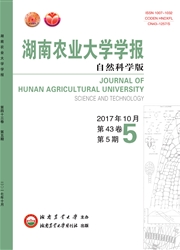

 中文摘要:
中文摘要:
为探讨不同大豆品种耐镉能力的差异,采用营养液培养,对10个大豆品种的Cd毒害效应及耐Cd差异性进行了研究.结果表明,10个大豆品种添加2.50mg/LCd培养14d后,大豆株高及生物产量均低于对照,不同品种间差异显著,其中湘春豆13、沔1101和本地种下降较少,为抗Cd毒害能力较强的品种.大豆的耐cd能力与其体内cd含量及Cd化学形态、根系活力(TTC)、POD活性等密切相关,耐Cd品种表现为:1)单位质量生物产量吸收累积的cd较其他品种低,Cd在植物体内主要以NaCl提取态形式存在,乙醇和水提取态Cd含量相对较少;2)根系活力相对较弱,吸Cd能力较差;3)Cd胁迫后POD活性增加较缓.
 英文摘要:
英文摘要:
Soybean is a sensitive crop to cadmium. Cadmium tolerance of various soybean varieties is different because of their inheritance. A nutrient hydroponic experiment was conducted to probe the toxic effects of cadmium and mechanism of tolerance to cadmium in 10 soybean varieties. The results showed that the height and biomass of 10 soybeans varieties at 2.50 mg/L Cd treatments decreased more significantly than control. The toxicity of cadmium exhibited significant differences among soybean varieties. Among 10 soybean varieties, Xiangchundou 13, Mian 1101 and local varieties showed higher tolerance to cadmium. And cadmium tolerance was closely related to contents and form of cadmium, roots vitalities and peroxidase (POD) activities. Soybean varieties with higher cadmium tolerance showed the following features,①Cadmium accumulation of unit biomass product was lower compared to other varieties, the main form of cadmium was NaCl extractive Cd, while the contents of ethanol and water extractive Cd was lower. ②Roots vitalities and cadmium uptake were lower that of other varieties, ③ Peroxidase activities showed a slight increase at cadmium stress.
 同期刊论文项目
同期刊论文项目
 同项目期刊论文
同项目期刊论文
 期刊信息
期刊信息
